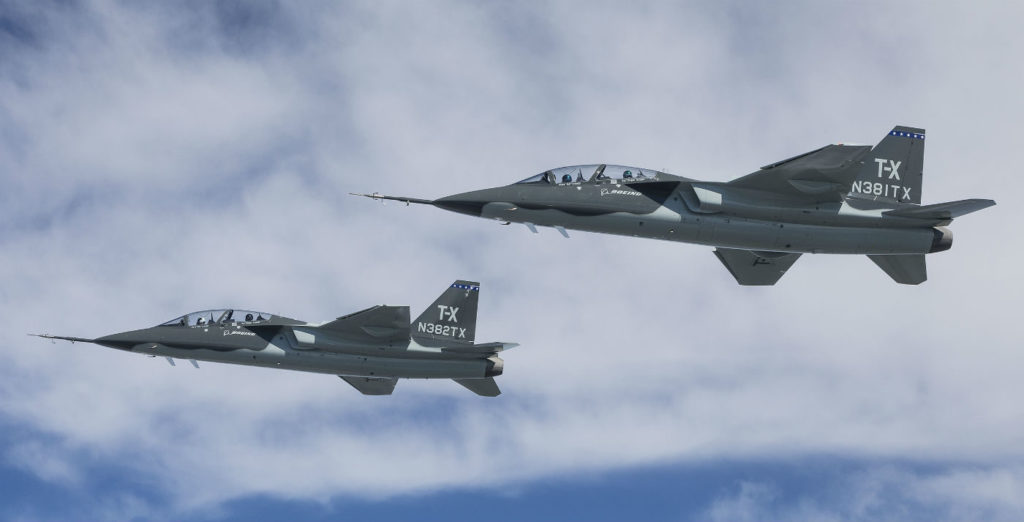Estimated reading time 4 minutes, 47 seconds.
Boeing and partner Saab completed the first flight of the all-new T-X aircraft on Dec. 20, 2016. The first flight of the second production-ready Boeing T-X aircraft occurred April 24, 2017, and both jets flew together for the first time on April 27, 2017.

Boeing T-X Advanced Pilot Training System
The Boeing T-X is an all-new advanced pilot training system designed specifically for the U.S. Air Force training mission. It includes trainer aircraft, ground-based training and support–designed together from the ground up. The U.S. Air Force Advanced Pilot Training System competition, commonly known as T-X, is designed to replace the T-38 trainer in use today. It will help train fighter and bomber pilots for generations to come.
General characteristics
The Boeing T-X aircraft has one engine, twin tails, stadium seating and an advanced cockpit with embedded training. It’s the cornerstone of the complete advanced pilot training system, which also includes state-of-the-art ground-based training and a maintenance-friendly design for long-term supportability.
The clean-sheet approach allows use of the latest technology, tools and manufacturing techniques–creating a more affordable and flexible option than older, existing aircraft. The system is also designed to evolve as technology, missions and training needs change.
Fighter-like design and performance: twin tails, GE F404 engine, and high G and high angle-of-attack capability. Boeing T-X is designed to look, feel and perform like fighter aircraft. The twin-tail design offers improved stability and is visually similar to current and future fighters, to enhance training. Twin tails provide excellent control, inherent speed break functionality, and safer air refueling.
- Stadium seating: JPATS 1-7 compatible with outstanding visibility. Stadium seating allows for ideal instructor positioning and visibility for flight instruction, from teaching basic traffic pattern operations to advanced visual air combat training. And, JPATS 1-7 compliant seating allows a wider range of individuals to train and instruct.
- Maintenance-friendly design: high wings, easy access panels and easy reach. The Boeing T-X design focuses on accessibility, fewer and more common fasteners, and readiness of critical items like engine and seats. It is also designed around common U.S. Air Force ground equipment and uses established suppliers to reduce supply chain complexity.
- Advanced cockpit: clean, intuitive and reconfigurable. A modern fighter-like cockpit, flexible avionics and a reconfigurable large area display allow students and instructors a maximum range of training options.
- Safety designed-in: stable, student- and instructor-friendly platform. Boeing T-X offers fly-by-wire flight controls, ample thrust, and excellent handling at all speeds, configurations and high angle-of-attack.
- Real-as-it-gets training. Boeing T-X is a complete advanced pilot training solution providing real-as-it-gets simulation, interactive classroom lessons, computer-based training modules, adaptive training that adjusts to students’ needs, and a complete suite of instructor tools-for optimum results on the ground and in the ‘classroom in the sky.’
Background:
- Boeing signed a joint development agreement with Saab in December 2013, to compete for T-X with an all-new, purpose-built design;
- Boeing revealed its first production aircraft, the cornerstone of the complete Boeing T-X advanced pilot training system, in St. Louis Sept. 13, 2016;
- Boeing and partner Saab completed the first flight of the all-new T-X aircraft Dec. 20, 2016. During the flight, the pilots validated key aspects of the single-engine jet and demonstrated the performance of the low-risk design. The first aircraft has continued to be flown, sometimes numerous times in a single day;
- The first flight of the second production-ready T-X aircraft occurred April 24, 2017, and both jets flew together for the first time April 27; and
- T-X is a top priority for the U.S. Air Force. The initial acquisition is expected to include 350 aircraft and the associated ground-based training and support.








